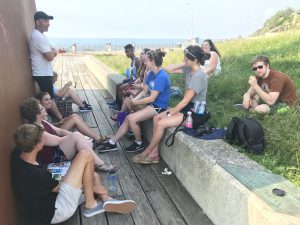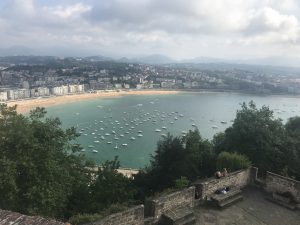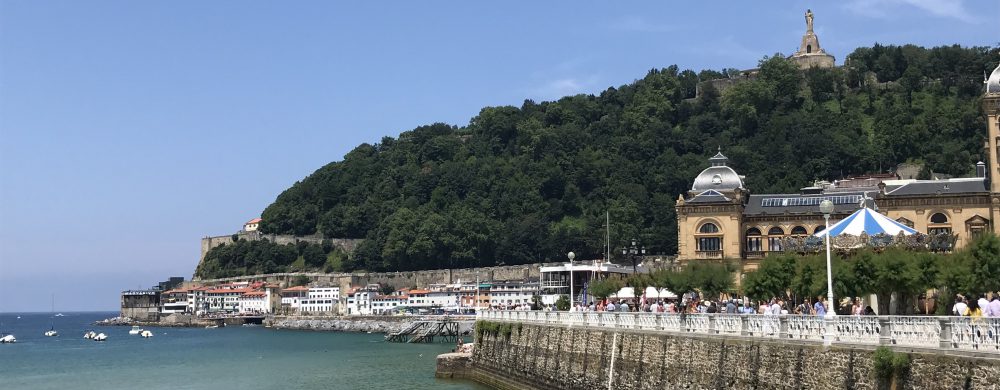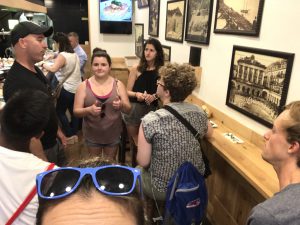 As I live and breathe in the air of San Sebastián, I learn more and more about the Basque culture every day. On Wednesday I learned the most about pintxos, the most commonly found kind of food here in San Sebastián—through a food tour.
As I live and breathe in the air of San Sebastián, I learn more and more about the Basque culture every day. On Wednesday I learned the most about pintxos, the most commonly found kind of food here in San Sebastián—through a food tour.
What’s a Pintxo?
The word “pintxo” in Basque comes from the Spanish word “pinchar” which in English means “to puncture” or “to prod.” A pintxo is most classically known as a stack of food skewered with a toothpick to keep it all together, or more generally, a snack-size food featurette that costs 1.5 to 6 € apiece. The custom at lunchtime (1-4pm here in San Sebastián) Is to have a pintxo or both a pintxo and a drink at one bar, then move onto the next bar for your next pintxo and drink, typically 3 to 5 times for a meal or until you are full.
…Bars?
Bar-hopping at lunchtime in San Sebastián does not carry the same connotations as it might in Boston. Firstly, the food is of world-class quality (https://bit.ly/2mtR3ie). Secondly, the social atmosphere and expectation is such that it is quite normal to eat one pintxo at this bar, another at the next, and finally hop a couple streets over to visit your favorite bartender at another. Some will have a drink with their pintxo at the bar before moving to the next bar. Some will run into a friend and have a chat. Most will bring friends and have a great time all the while. The atmosphere is very social, open, and inviting: grab a pintxo, enjoy, and pay before you leave.
Finding a Pintxo Bar
The way you can spot a good pintxo bar is either that (1) It’s so crowded that you can’t even squeeze in, or (2) It has a plethora of crumpled up napkins on the floor. While number one is somewhat self-explanatory, number two calls for a bit of an explanation. A casual American tourist could easily think that napkins populate the floor due to sloppy patrons, but this is not the case. When you have eaten a really good pintxo, you grab a napkin from the dispenser (a small slip of paper), wipe your greasy fingers, then toss the crumpled napkin on the floor. This token indicates that you’ve enjoyed the bite you had to eat, and the accumulation of such tokens serves as a sign to others that they might just want to stop in. Of course, if I bar is incredibly crowded and ALSO has tons of napkins on the floor, you might want to plan on lining up there before opening time tomorrow!
Featured Pintxos
OK, now to the good part; the part where I just play a plethora of mouthwatering morsels. Here are the top three out of the 17 pintxos from the pintxo tour we took today as a class…
1. Pork rib. This pintxo was a delectable treat at the Bar Borda Berri that arrived steaming with a crispy, caramelized layer on the outside. The golden brown crisp and the tender meat beneath paired incredibly with a piece of a fresh roll of bread.
2. Gilda. The most classic pintxo around, the Gilda is made of green olive(s), mini pickled hot peppers, and an anchovy, skewered together. It was named after the 1946 film starring Rita Hayworth, whose image on the movie poster has been described as “savory, green, and a little spicy” — thus this pintxo’s name.
3. Risotto. This pintxo was also a special of Borda Berri, and brought incredible flavors to the table. Made from Spanish rice and the milk of pasture-fed sheep. It was creamy with a delightful, rich, aromatic flavor. Drizzled over the top was a parsley-garlic olive oil which added a facet of fresh flavor to the aroma.
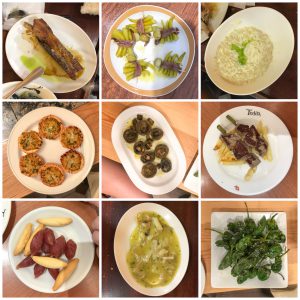
Top, left to right: Pork Rib, Gilda, Risotto & 6 More
Though we all felt like Violet Beauregarde (Blueberry-girl from Willy Wonka) when we were finished, we stuck it out for some Basque Cheesecake and a Café Cortado to finish out the class. (A Cortado is a shot of espresso cut by a swift pour of frothed milk.) The espresso paired brilliantly with the light, fluffy cheesecake, and also ensured that I would not immediately be overtaken by a food coma.
Reflections
Not only was this my favorite class in the history of my school career (fooood), but it was an incredible peek into the public food culture of the Basque Country, which treats food in a completely different manner than Bostonians. Though I realize that I will likely not be able to eat in this fashion for 99% of my life, I am grateful to have tasted 17 pintxos of San Sebastián with a group of other students also experiencing it for the first time with a knowledgeable professor at the helm. It is for these moments and experiences that I chose to study abroad, and it hasn’t disappointed yet!!
